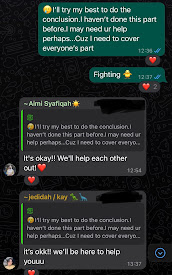Course Outline
It was time for the eighth week of the course ~ at the beginning of the course the lecturer explained the planning of assignments such as our lesson plans must be based on language teaching. The first topic in this lecture was learning objectives, she introduced the SMART model of setting objectives and how to use Bloom's classification to write learning objectives. The second topic was questioning, she introduced us to the meaning and classification of questioning, the concept of the question circle and categorised cognitive levels into domains using Bloom's Taxonomy of Learning.
Learning Objective
To achieve learning objectives, instructional objectives are carefully crafted to encompass all cognitive levels. These objectives serve as guidelines for teachers, helping them design lessons and activities that target specific cognitive skills at appropriate levels of complexity. For instance, while some objectives may focus on simple knowledge recall or comprehension tasks, others aim to foster critical thinking or analytical reasoning. By incorporating a variety of cognitive skills into their instructional planning, educators can create a well-rounded curriculum that caters to the diverse needs and abilities of students. This approach ensures that students not only acquire basic knowledge recall but also develop higher-order thinking and problem-solving abilities.

While Bloom's Taxonomy provides a framework for classifying and organising cognitive skills at different levels (Adams, 2015). By using it, information professionals can clearly define the skills and competencies they want learners to acquire and demonstrate. When designing lesson plans, learning objectives can be categorised into different levels based on Bloom's Taxonomy: remembering, understanding, applying, analysing, evaluating and creating (Doughty, 2006).The first time I came across Bloom's taxonomy was in the autumn term of Year 1, when we were asked to complete a lesson plan that required us to pick words from the Bloom's taxonomy glossary. At first, I did not understand the rationale behind this and just followed what the lecturer asked us to do. However, after going through this lesson, I gradually realised the importance of Bloom's taxonomy which can be used to write learning objectives as an information professional which trains or instructs learners. This explains the reason that whenever I write a lesson plan, I am always required to open the word list of Bloom's taxonomy and find the verbs that correspond to the learning objectives of each level.

The concept of the Smart Model for objective setting is completely new to me, and I find it intriguing. It presents a fresh approach to goal setting for me. This model appears to provide a structured framework for defining specific, measurable, achievable, relevant, and time-bound objectives (Doran,1981). By incorporating these five key elements into the objective setting, the Smart Model ensures that goals are well-defined and aligned with overall strategies. The specificity aspect helps in clearly articulating what needs to be achieved.
The Smart model, however, allows for more efficient implemetation of instructional objectives. For example, my instructional objective is to improve students' reading comprehension skills in English, where the traditional objective would be enhance reading skills or better understanding of reading1. But with the Smart model it can be modified as below:
Specific: Improve students' ability to analyze and interpret complex texts by focusing on main ideas, supporting details, and inferences.
Measurable: Increase students' average score on weekly comprehension assessments by 10% over the next two months.
Achievable: Increase the percentage of correct reading questions by 5% within the given timeframe. (It's not a very ambitious goal and could be achievable)
Relevant: Strengthen core reading skills to enable students to comprehend and analyze a variety of literary genres, including fiction, non-fiction, and poetry.
Time-Bound: Achieve a 10% increase in reading comprehension scores on weekly assessments within the next two months.
This also reminds me that in primary school, the Chinese teacher started a reading competition in the class to cultivate our reading habits. She created a table for the whole class, on which a star could be drawn once a book had been read, and then each student's reading was assessed according to the number of stars. This is a vivid example of converting teaching objectives into measurable ones.Questioning
Questioning has always been seen as a key step in learning, and it plays a crucial role in the acquisition of knowledge and understanding. In fact, many educational theorists and researchers have emphasized the importance of questioning in the learning process.
Morgan and Saxton (1991) stated that learning and questioning are usually thought to be related because asking questions allows individuals to actively engage with the material they are trying to learn. By asking questions, learners can clarify their doubts, explore new ideas, and deepen their understanding of a subject matter.
Questioning is often identified as one of the distinctive traits of learning because it demonstrates curiosity and critical thinking skills (Cifone, 2013). When students ask questions, they demonstrate an active involvement in their own education by seeking clarification or challenging existing knowledge. This not only enhances their comprehension but also fosters independent thinking abilities.
In my opinion, questioning also promotes effective communication between teachers and students. This encourages dialogue in the classroom where both parties can exchange ideas, share perspectives, and collaborate on problem-solving tasks. Through this interactive process of questioning and answering, students develop stronger cognitive skills while teachers gain insights into student comprehension levels.Career inspiration
This class was extremely beneficial to me as it provided me with valuable insights and practical skills that will greatly enhance my abilities both as a student and as a future educator.
As a student, I gained a thorough understanding of how to effectively utilize Bloom's Taxonomy in developing lesson plans for assignments. This knowledge has empowered me to create well-structured and engaging lessons that cater to the diverse learning needs of my students.It also equipped me with the necessary tools to improve my questioning techniques when interacting with teachers in future lessons. I have learned how to ask thoughtful and probing questions that not only deepen my own understanding but also foster meaningful discussions within the classroom setting. By mastering effective questioning strategies, I am confident that I will be able to actively engage with my teachers, seek clarification when needed, and maximize my learning potential.

As an aspiring educator, this course has been invaluable in shaping my approach towards creating comprehensive lesson plans for my future students. Through various instructional methods taught in this class, such as backward design and differentiated instruction, I now possess the ability to develop tailored lesson plans that address individual student needs while promoting inclusivity within the classroom environment. One significant aspect emphasized throughout this course is the importance of encouraging questions. By implementing strategies discussed in this class like open-ended prompts or providing safe spaces for inquiry-based learning, I can cultivate an atmosphere where curiosity is nurtured and students feel comfortable expressing their thoughts and seeking further knowledge.
References
Adams, N. E. (2015). Bloom’s Taxonomy of Cognitive Learning Objectives. Journal of the Medical Library Association : JMLA, 103(3), 152–153. https://doi.org/10.3163/1536-5050.103.3.010
Cifone, M. V. (2013). Questioning and learning. Curriculum and Teaching Dialogue, 15(1), 41-55.
Doran, G. T. (1981). There’sa SMART way to write management’s goals and objectives. Management review, 70(11), 35-36.
Doughty, H. A. (2006). Blooming Idiots: Educational Objectives, Learning Taxonomies and the Pedagogy of Benjamin Bloom. College Quarterly, 9(4). https://eric.ed.gov/?id=EJ835427
Morgan, N., & Saxton, J. (1991). Teaching, questioning and learning.












.jpeg)





















